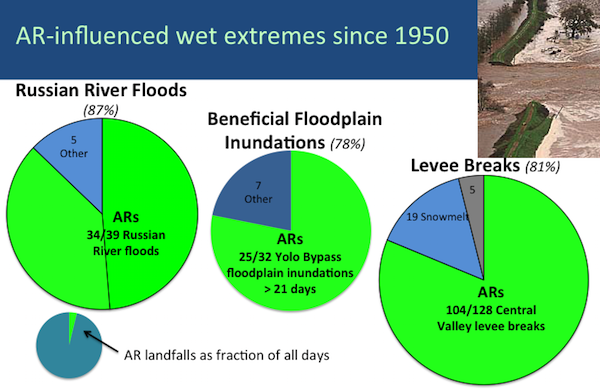CalWater-2/ARM Cloud Aerosol Precipitation Experiment (ACAPEX): AGU session
January 2, 2015
The influence of Atmospheric Rivers (ARs) on wet extremes since 1950 are shown by the fraction of AR landfall days (green portion of pie chart). Note, for example, 87% of flood days for the Russian River are AR landfall days.
The Fall 2014 AGU meeting in San Francisco hosted a workshop/press conference describing the upcoming 2015 field campaign: CalWater2 / ARM Cloud Aerosol Precipitation Experiment (ACAPEX). Scientists from Scripps Institution of Oceanography at UC San Diego, the Department of Energy’s Pacific Northwest National Laboratory (PNNL), and NOAA discussed the impetus behind the field campaign to begin in early 2015. The panel described how ground-based, multiple-aircraft, and ship-based measurements will help provide a better understanding of how California gets its rain and snow, how human activities are influencing precipitation, and how the new science provides potential to inform water management decisions relating to drought and flood. One of the related presentations was given by CW3E PI Mike Dettinger. Dr. Dettinger, AGU 2014 Fellow, described historical and future impacts of land-falling ARs. The image above, from his presentation, depicts the influence of AR land-falling days on extreme wet events in California (Russian River floods, flood plain inundations and levee breaks).
Click here for the UCSD/SIO press release about the workshop / press conference.
Click here for the related UCSD/SIO news story about “Refilling California’s Reservoirs—The Roles of Aerosols and Atmospheric Rivers”.
Click here to follow the CalWater-2 / ACAPEX field project forecasts.

